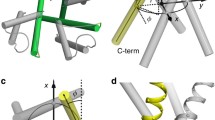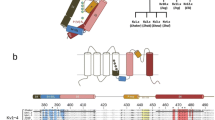Abstract
The family of P-loop channels includes potassium, sodium, calcium, cyclic nucleotide-gated and TRPV channels, as well as ionotropic glutamate receptors. Despite vastly different physiological and pharmacological properties, the channels have structurally conserved folding of the pore domain. Furthermore, crystallographic data demonstrate surprisingly similar mutual disposition of transmembrane and membrane-diving helices. To understand determinants of this conservation, here we have compared available high-resolution structures of sodium, potassium, and TRPV1 channels. We found that some residues, which are in matching positions of the sequence alignment, occur in different positions in the 3D alignment. Surprisingly, we found 3D mismatches in well-packed P-helices. Analysis of energetics of individual residues in Monte Carlo minimized structures revealed cyclic patterns of energetically favorable inter- and intra-subunit contacts of P-helices with S6 helices. The inter-subunit contacts are rather conserved in all the channels, whereas the intra-subunit contacts are specific for particular types of the channels. Our results suggest that these residue–residue contacts contribute to the folding stabilization. Analysis of such contacts is important for structural and phylogenetic studies of homologous proteins.




Similar content being viewed by others
Abbreviations
- MC:
-
Monte Carlo
- MCM:
-
MC-minimization
- RMSD:
-
Root mean square deviation
- S6:
-
Pore-lining inner transmembrane helices in P-loop channels
- S5:
-
Lipid facing outer transmembrane helices in P-loop channels
References
Bagneris C, DeCaen PG, Naylor CE, Pryde DC, Nobeli I, Clapham DE, Wallace BA (2014) Prokaryotic NavMs channel as a structural and functional model for eukaryotic sodium channel antagonism. Proc Natl Acad Sci USA 111:8428–8433
Bernèche S, Roux B (2002) The ionization state and the conformation of Glu-71 in the KcsA K + channel. Biophys J 82:772–780
Biel M, Michalakis S (2009) Cyclic nucleotide-gated channels. In: Schmidt HHW, Hofmann F, Stasch J-P (eds) cGMP: generators, effectors and therapeutic implications, vol 191. Springer, Berlin, Heidelberg, pp 111–136
Bruhova I, Zhorov BS (2005) KvAP-based model of the pore region of shaker potassium channel is consistent with cadmium- and ligand-binding experiments. Biophys J 89:1020–1029
Clarke OB, Caputo AT, Hill AP, Vandenberg JI, Smith BJ, Gulbis JM (2010) Domain reorientation and rotation of an intracellular assembly regulate conduction in Kir potassium channels. Cell 141:1018–1029
Clayton GM, Altieri S, Heginbotham L, Unger VM, Morais-Cabral JH (2008) Structure of the transmembrane regions of a bacterial cyclic nucleotide-regulated channel. Proc Natl Acad Sci USA 105:1511–1515
Doyle DA, Morais Cabral J, Pfuetzner RA, Kuo A, Gulbis JM, Cohen SL, Chait BT, MacKinnon R (1998) The structure of the potassium channel: molecular basis of K + conduction and selectivity. Science 280:69–77
Garden D, Zhorov B (2010) Docking flexible ligands in proteins with a solvent exposure- and distance-dependent dielectric function. J Comput Aided Mol Des 24:91–105
Hellmich UA, Gaudet R (2014) Structural biology of TRP channels. Handbook Exp Pharmacol 223:963–990
Huber I, Wappl E, Herzog A, Mitterdorfer J, Glossmann H, Langer T, Striessnig J (2000) Conserved Ca2 + -antagonist-binding properties and putative folding structure of a recombinant high-affinity dihydropyridine-binding domain. Biochem J 347(Pt 3):829–836
Irizarry SN, Kutluay E, Drews G, Hart SJ, Heginbotham L (2002) Opening the KcsA K + channel: tryptophan scanning and complementation analysis lead to mutants with altered gating. Biochemistry 41:13653–13662
Jiang Y, Lee A, Chen J, Cadene M, Chait BT, MacKinnon R (2002) Crystal structure and mechanism of a calcium-gated potassium channel. Nature 417:515–522
Jiang Y, Lee A, Chen J, Ruta V, Cadene M, Chait BT, MacKinnon R (2003) X-ray structure of a voltage-dependent K + channel. Nature 423:33–41
Paulsen CE, Armache J-P, Gao Y, Cheng Y, Julius, D (2015) Structure of the TRPA1 ion channel suggests regulatory mechanisms. Nature (advance online publication)
Kalia J, Swartz KJ (2013) Exploring structure-function relationships between TRP and Kv channels. Sci Rep 3:1523
Karakas E, Furukawa H (2014) Crystal structure of a heterotetrameric NMDA receptor ion channel. Science 344:992–997
Lee JH, Lee Y, Ryu H, Kang DW, Lee J, Lazar J, Pearce LV, Pavlyukovets VA, Blumberg PM, Choi S (2011) Structural insights into transient receptor potential vanilloid type 1 (TRPV1) from homology modeling, flexible docking, and mutational studies. J Comput Aided Mol Des 25:317–327
Li Z, Scheraga HA (1987) Monte Carlo-minimization approach to the multiple-minima problem in protein folding. Proc Natl Acad Sci 84:6611–6615
Liao M, Cao E, Julius D, Cheng Y (2013) Structure of the TRPV1 ion channel determined by electron cryo-microscopy. Nature 504:107–112
Lipkind GM, Fozzard HA (2000) KcsA crystal structure as framework for a molecular model of the Na(+) channel pore. Biochemistry 39:8161–8170
Long SB, Campbell EB, Mackinnon R (2005) Crystal structure of a mammalian voltage-dependent Shaker family K + channel. Science 309:897–903
Long SB, Tao X, Campbell EB, MacKinnon R (2007) Atomic structure of a voltage-dependent K + channel in a lipid membrane-like environment. Nature 450:376–382
Payandeh J, Scheuer T, Zheng N, Catterall WA (2011) The crystal structure of a voltage-gated sodium channel. Nature 475:353–358
Sobolevsky AI, Rosconi MP, Gouaux E (2009) X-ray structure, symmetry and mechanism of an AMPA-subtype glutamate receptor. Nature 462:745–756
Tikhonov DB, Zhorov BS (2005) Modeling P-loops domain of sodium channel: homology with potassium channels and interaction with ligands. Biophys J 88:184–197
Tikhonov DB, Zhorov BS (2012) Architecture and pore block of eukaryotic voltage-gated sodium channels in view of NavAb bacterial sodium channel structure. Mol Pharmacol 82:97–104
Tikhonov DB, Bruhova I, Garden DP, Zhorov BS (2015) State-dependent inter-repeat contacts of exceptionally conserved asparagines in the inner helices of sodium and calcium channels. Pflugers Archiv: Eur J Physiol 467:253–266
Weiner SJ, Kollman PA, Case DA, Singh UC, Ghio C, Alagona G, Profeta S, Weiner P (1984) A new force field for molecular mechanical simulation of nucleic acids and proteins. J Am Chem Soc 106:765–784
Weiner SJ, Kollman PA, Nguyen DT, Case DA (1986) An all atom force field for simulations of proteins and nucleic acids. J Comput Chem 7:230–252
Yamagishi T, Li RA, Hsu K, Marban E, Tomaselli GF (2001) Molecular architecture of the voltage-dependent Na channel: functional evidence for alpha helices in the pore. J General Physiol 118:171–182
Yifrach O, MacKinnon R (2002) Energetics of pore opening in a voltage-gated K(+) channel. Cell 111:231–239
Zagotta WN, Olivier NB, Black KD, Young EC, Olson R, Gouaux E (2003) Structural basis for modulation and agonist specificity of HCN pacemaker channels. Nature 425:200–205
Zhang X, Ren W, DeCaen P, Yan C, Tao X, Tang L, Wang J, Hasegawa K, Kumasaka T, He J, Wang J, Clapham DE, Yan N (2012) Crystal structure of an orthologue of the NaChBac voltage-gated sodium channel. Nature 486:130–134
Zhorov BS, Tikhonov DB (2004) Potassium, sodium, calcium and glutamate-gated channels: pore architecture and ligand action. J Neurochem 88:782–799
Zhorov BS, Folkman EV, Ananthanarayanan VS (2001) Homology model of dihydropyridine receptor: implications for L-type Ca(2 +) channel modulation by agonists and antagonists. Arch Biochem Biophys 393:22–41
Acknowledgments
Computations were made possible by the facilities of the Shared Hierarchical Academic Research Computing Network (SHARCNET). This study was supported by grants 13-04-40081H to DBT and 14-04-00378 to BSZ from the Russian Foundation for Basic Research and by grant GRPIN-2014-04894 to BSZ from the Natural Sciences and Engineering Research Council of Canada.
Author information
Authors and Affiliations
Corresponding author
Rights and permissions
About this article
Cite this article
Korkosh, V.S., Zhorov, B.S. & Tikhonov, D.B. Analysis of inter-residue contacts reveals folding stabilizers in P-loops of potassium, sodium, and TRPV channels. Eur Biophys J 45, 321–329 (2016). https://doi.org/10.1007/s00249-015-1098-6
Received:
Revised:
Accepted:
Published:
Issue Date:
DOI: https://doi.org/10.1007/s00249-015-1098-6




